| How about literature in Han Dynasty? The Han Dynasty (206 BC to AD 220) actively promoted the restoration and teaching of the Classics. In 124 BC a national university was opened for the purpose of teaching Confucianism.Literature came back into existence during the Han Dynasty. Traditional poetry and prose forms, especially the fu prose poems, flourished. But the most notable achievement came with the reactivation of the Music Bureau, in 125 BC. The most outstanding folk ballad of the period, about AD 200, was Southeast the Peacock Flies. | 
|
The major prose authors of the Han Dynasty were Liu An, Ssu-ma Ch'ien, and Pan Ku. The masterpiece of the period was the Shih-chi. It was completed in about 85 BC and took 18 years to produce. It contains a record of events and personalities from the previous 2,000 years. Shih-chi was the first attempt at a national history in China, and it set the pattern for the histories of dynasties in the following centuries. Pan Ku, who was born about AD 32 and died about AD 92, was also a poet, soldier, and the author of `Han shu'. Completed after 16 years of study, the history contains more than 800,000 words. |